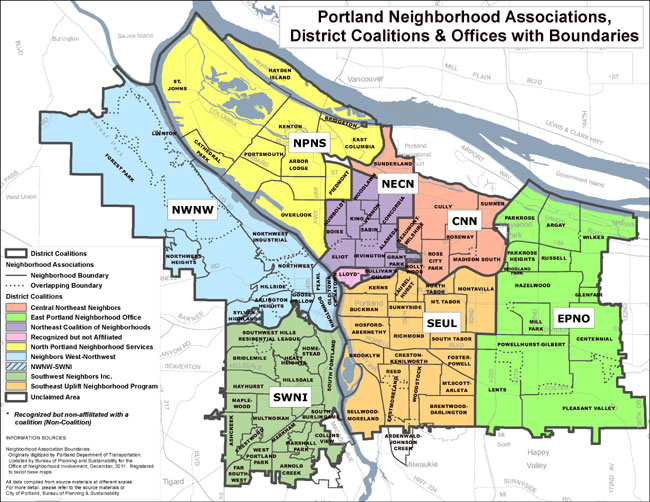
by Glenn Devitt | Sep 28, 2016 | Business Community, Outreach
In Portland’s Sunnyside neighborhood – and in other neighborhoods – we’ve collaborated with a supportive Neighborhood Association (NA), and it has been extremely productive and mutually rewarding. We offer a summary of our experience hoping that it will be useful to other Neighborhood Emergency Teams (NETs).
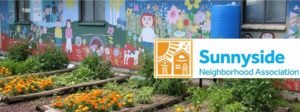
SUNNYSIDE’S RESULTS:
- In a little over a year, more than 200 non-NET neighbors have joined our email list, and hundreds more have attended meetings or outreach events. Some do not have the time or desire to get NET Basic Training, and others are satisfied preparing “only” their block using Map Your Neighborhood. That’s fine. We want all of these people to be aware of each other and to share training resources. And we want to meet them before an emergency occurs.
- Each neighbor with an emergency kit makes for one less household you’ll need to worry about in an emergency – plus, they might be able to help as a Spontaneous Unaffiliated Volunteer (SUV) or Affiliated Trained Volunteer (ATV).
- We have supported several block parties/meetings where neighbors meet and create a plan for their micro-neighborhood.
- We are integrating with our NA’s Crime Prevention Committee, and the Office of Neighborhood Involvement’s Neighborhood Watch program. It’s a no-brainer: recruit civic-minded people wherever possible.
HOW:
The “Sunnyside Prepared” committee was founded to recognize the need to work with everyone in the community who is interested in preparedness, not only NETs. Sunnyside has 6,000+ residents and fewer than 20 NETs. We need all hands on deck. The committee was proposed to and approved by our Neighborhood Association, who recognize the value in supporting this work. We proposed an itemized budget, and the NA board happily approved it out of their funds.
We also segment our monthly meetings into general “emergency prep” and NET portions. Everyone is welcome to attend all, unless we plan to discuss confidential information only approved for NETs.
PROS:
There are so many reasons to do this!
Fundraising
As you may already know, PBEM/NET enables teams to accept tax-deductible donations through the Friends of Portland Fire & Rescue for equipment cache and supplies (see NET Guidelines doc for details). We cannot raise money through NAs due to their legal structure – BUT we can request money directly from NAs for other costs like printing and postage, tabling supplies, and giveaways. So:
Mo’ Money
Request a budget from your NA! We are aware of teams receiving $250 – $1,500 annually. Keep a keen eye on your accounting and use money strictly for its approved purposes; it is very important to keep your Friends of Portland Fire & Rescue and NA accounts and ledgers separate. And proactively report to your NA how its funding improved your outreach and performance. How many people attended events? How many brochures were distributed? Also account for in-kind costs you do not incur but which support your work, e.g. materials from PBEM. Your NA needs to understand the total return on its investment.
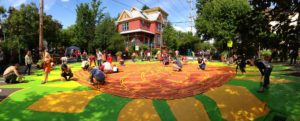
Public Outreach
You will reach a much wider audience through your NA’s calendar and newsletter, as well as NextDoor.com. Your NA probably gets a booth at local street fairs at no cost. Ask to use/share it.
School Outreach
With official recognition by your NA, school administrators will be more likely to welcome your collaboration. Mention that NETs are background-checked by PBEM; of course, school staff do not allow strangers to wander school grounds. PPS has its own background check process that they may ask you to complete.
Business Outreach
As a public agency, PBEM cannot support any activity that might be perceived as endorsing a business. However NAs can, and their endorsement legitimizes your outreach to local businesses. See the PortlandPrepares.org article NET + Business Partnership = Win Win Win. We are considering a window-sticker campaign to “brand” our neighborhood businesses for emergency preparedness.
Website
Your NA might be able to give you a page on their site at no cost (like SunnysidePrepared.com) or at least a link to your team’s page on PortlandPrepares.com.
City Discounts
Committees of NAs may place orders through the City’s Printing & Distribution office (SW 2nd & Main), whose rates are usually better than retail. Plus, with pre-approval for each order, they bill the NA directly so you don’t need to go out-of-pocket.
Satisfaction
Once you get going, you will become one of your NA’s most productive and active committees. And that leads to more support and mutual reward.
CONS:
- Neighborhood Association boards change. Ours is amazingly cooperative, though we’ve heard about contentious NAs in other parts of the city. Establish your committee outside the politics of other issues and be sure to report about the value you’re contributing. That should help ensure that your NA’s support will endure.
- At some meetings you will be mingling trained NETs with the general public, so balance NET exercises with an increase in outreach to people just beginning their personal emergency preparedness.
- Consider appointing an ATL to primarily handle outreach and ensure that you don’t neglect your other TL duties. To explore this, we plan to test separating our monthly public meetings with separate quarterly NET exercises.
We hope our experience will be useful to you. PLEASE, share your experiences with us. We would like to revise this piece in the future to incorporate great ideas that other teams share.
Glenn C. Devitt, Sunnyside Team Lead, Sunnyside Prepared Co-Chair, Friends of Portland NET co-founder, glenn@sunnysideprepared.com, 503.345.4321
Jan Molinaro, Sunnyside Assistant Team Lead, Sunnyside Prepared Co-Chair, jan@sunnysideprepared.com
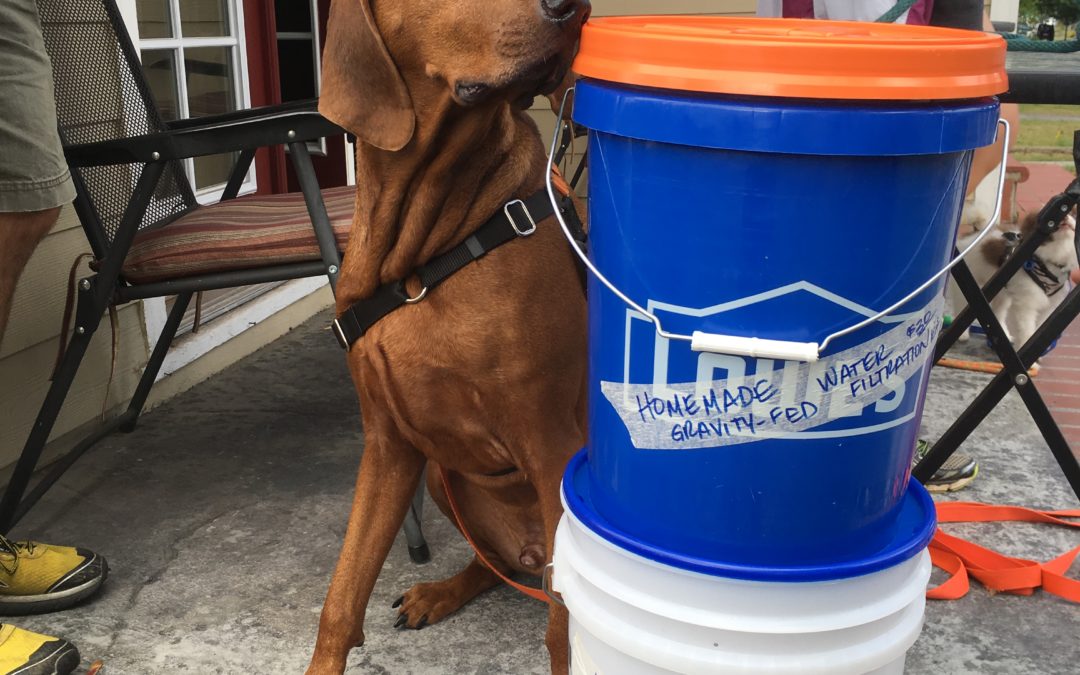
by Susan Ronning | Sep 18, 2016 | Kit Preparation & Planning
My husband and I planned a camping trip to Waldo Lake. It was a place he’d heard so much about but hadn’t yet visited. About a three weeks before our reservation, we received a notice from the campground that there would be no fresh drinking water available due to a broken line which wouldn’t be fixed in time. We could cancel our reservation with a full refund or continue on and make due by bringing our own water or filtering the lake water. Heck, we’ve been backpacking and have had to filter water before. Not to worry, we would figure something out and press on.
KING OF THE BACKPACKING TRIP
John and I had only ever used hand-pump water filters for backpacking. They are a lot of work for not much gain. On a previous backpacking trip, a friend of ours had brought along a Platypus brand gravity fed filter system designed to hang from a tree. He was KING of that backpacking trip. We took turns filling his water bag and letting his filter do the leg-work while we cooked, chatted, and slept. Gravity-fed filters… now that’s the way to go!
HOMEMADE GRAVITY SYSTEM
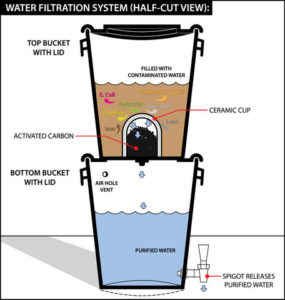 Before embarking on our camping trip, I scoured the internet looking for more gravity-fed filtration options. Lo and behold, I found a video of how to assemble a home-built system. This two-bucket ceramic gravity-fed filter system would be a perfect solution for car camping. We built it and used it successfully on that trip.
Before embarking on our camping trip, I scoured the internet looking for more gravity-fed filtration options. Lo and behold, I found a video of how to assemble a home-built system. This two-bucket ceramic gravity-fed filter system would be a perfect solution for car camping. We built it and used it successfully on that trip.
I realized this system would work perfectly in our home preparedness kit. We have rain barrels around our house and intend for that to be our water source. But drinking THAT water — uggh! It would need to be filtered.
FILTRATION IS NOT ENOUGH
After talking to more people, there were concerns about the level of sanitation. How many microns? What about viruses? It turns out that ceramic filters only filter, which is to say they remove particles and bacteria – not viruses and chemicals, so purification is still required. I’ve since found that Berkey filters can purify to the virus level as well as iodine tablets. We haven’t tried it out yet, but that’s our next step. Or we’ll just boil whatever water we don’t trust to drink.
–Written by Susan Ronning, Team Lead for the Arbor Lodge / Kenton NET (susanebe@gmail.com)
updated 2017-05-31
Have comments or want to share your findings? Share them with the PortlandPrepares Facebook Group.
WHERE TO BUY GRAVITY-FED KITS:
ADDITIONAL RESOURCES:
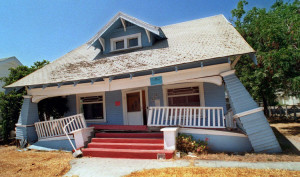
by Laura Hall | Sep 2, 2016 | Map Your Neighborhood, Outreach
How many of you live within walking distance of your friends and family? Probably not many. When the Cascadia quake hits, there will be no more internet, cell phones, or visits to friends across town. Your radius will shrink. The people in your world will be those who are actually right there near you. And there’s a good chance it will happen when you’re at home.
WHO WILL COME TO YOUR AID?

Government assistance may take weeks to arrive. Our immediate survival and long-term comfort in a disaster can depend on our connections. If your loved ones are unable to help and you don’t know your neighbors,
Who will come get you out of your collapsed house?
Who will know to look for your children or pets?
Who will put out the fire if you are not there?
Who will you band together with to share skills and supplies?
DISASTERS CREATE COMMUNITY
From that first rescue to the procuring of water, food, and medicine, we will all likely need some help. When we trade help with those near to us, we will create new close bonds based on real human needs and personal contact. We will come to know who we can trust. People will be forced to cooperate when services and supply streams fail.
BEFORE A DISASTER FORCES IT
While disasters will create communities out of necessity, having strong communities in place before a disaster is far more effective. So how can we build a sustainable community that looks out for its members? How can we function like a tribe, with personal accountability and respect? The tribes that we create around sports teams or musical preferences may be useless in the face of real adversity, but good relations with our close neighbors could save our lives.
Many of us are not comfortable knocking on doors and introducing ourselves to neighbors. We’ve become accustomed to building social bubbles and respecting others’ bubbles to the point of not knowing the person living next door. Inviting neighbors to a Map Your Neighborhood party is a good way to break the ice. You can convene around the topic of neighborhood earthquake planning and get to know each other personally in the process.
- Make it a potluck – everyone loves food!
- Do it in August – the City of Portland waives block-party fees in celebration of National Night Out (check out their great Game Ideas).
- Don’t forget to emphasize the fact that if nothing else, everyone should be stockpiling water.
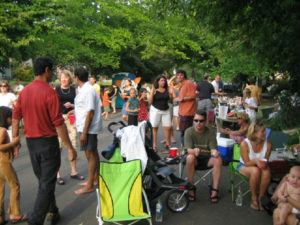
THE INTERNET CAN HELP
Social media can aid us in getting to know our neighbors. There are a number of platforms that seek to bring people together locally to convene around various topics or exchanges. Among others, NextDoor and Buy Nothing are active in Portland and worth considering.
- NextDoor.com seeks to build stronger and safer neighborhoods by providing a space for people to do things like: spread the word about a stolen car, organize a Neighborhood Watch Group, find a trustworthy babysitter, ask neighbors to keep an eye out for a lost dog, find a new home for an outgrown bike, or advertise a Neighborhood Emergency Team meeting. These online interactions often lead to in-person community building.
- The Buy Nothing Project on Facebook allows people to share good, skills, and knowledge in a format that values human connection above all else. The project’s values state, “We believe our hyper-local groups strengthen the social fabric of their communities, and ensure the health and vitality of each member… We measure wealth by the personal connections made and trust between people.”
GO SHAKE SOME HANDS
 Nothing can beat chatting with your neighbors on a regular basis. Make a point of waving and saying hello more. Make an opportunity to talk to the senior across the street about her garden. Make a double batch of muffins and go chat with the family next door.
Nothing can beat chatting with your neighbors on a regular basis. Make a point of waving and saying hello more. Make an opportunity to talk to the senior across the street about her garden. Make a double batch of muffins and go chat with the family next door.
It behooves us to prioritize people in a face-to-face way. Our most important preparedness (and happiness) goal may be to build close-proximity relationships. Long distance doesn’t help when you’re trapped under debris.
–Written by Laura Hall and Teresa Gryder








